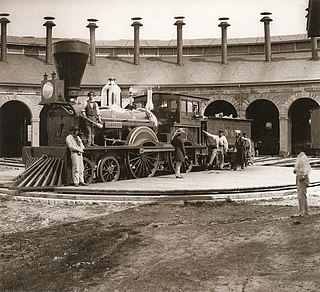| Overview | |
|---|---|
| Headquarters | Hamilton, Ontario |
| Locale | Niagara Peninsula, Ontario |
| Dates of operation | 1894–1931 |
| Technical | |
| Track gauge | 4 ft 8+1⁄2 in (1,435 mm) standard gauge |
The Hamilton, Grimsby and Beamsville Electric Railway (HG&B) was an interurban railway that operated between Hamilton and Vineland in the Niagara Peninsula in Ontario, Canada. It was incorporated in 1894.
Hamilton, Grimsby and Beamsville's interurban line ran for 22 miles along the southern shore of Lake Ontario. The HG&B interchanged freight cars with other lines in the Hamilton Radial System, with the TH&B [ Kinnear Yard] and with the Grand Trunk [ Winona]. Spur lines were constructed to Grimsby Park and the canning factories. The HG&B derived a large amount of revenue by hauling fruit grown in the northern section of the Niagara Peninsula. It built a car shop in Grimsby and a coal-fired steam-electric DC generator at Stoney Creek. In 1904 the HG&B began using AC power from Hamilton Cataract's hydro-electric generator at Decew Falls, two miles south of St. Catharines, It then converted its Stoney Creek DC station to an AC substation.
A 4.5-mile (7.2 km) extension from Beamsville to Vineland opened in 1904 with the hope of a connection to St. Catharines. The connection was never made as bridging the Twenty Mile Creek ravine was economically unfeasible.
The Vineland extension was abandoned in 1905 when local revenue was insufficient to cover operating costs, but its streetcar service was expanded to Oakville, with future plans to connect to the Toronto streetcar system in Port Credit. This failed to happen, and service was cut back to Burlington in 1925. In 1927, street car service stopped entirely. The company ended in 1931 when its line was abandoned and torn up.

The Pacific Electric Railway Company, nicknamed the Red Cars, was a privately owned mass transit system in Southern California consisting of electrically powered streetcars, interurban cars, and buses and was the largest electric railway system in the world in the 1920s. Organized around the city centers of Los Angeles and San Bernardino, it connected cities in Los Angeles County, Orange County, San Bernardino County and Riverside County.

The Interurban is a type of electric railway, with streetcar-like electric self-propelled rail cars which run within and between cities or towns. They were very prevalent in North America between 1900 and 1925 and were used primarily for passenger travel between cities and their surrounding suburban and rural communities. The concept spread to countries such as Japan, the Netherlands, Switzerland, Belgium, Italy and Poland. Interurban as a term encompassed the companies, their infrastructure, their cars that ran on the rails, and their service. In the United States, the early 1900s interurban was a valuable economic institution. Most roads between towns and many town streets were unpaved. Transportation and haulage was by horse-drawn carriages and carts. The interurban provided reliable transportation, particularly in winter weather, between the town and countryside. In 1915, 15,500 miles (24,900 km) of interurban railways were operating in the United States and, for a few years, interurban railways, including the numerous manufacturers of cars and equipment, were the fifth-largest industry in the country. By 1930, most interurbans in North America were gone with a few surviving into the 1950s.

Lincoln is a town on Lake Ontario in the Niagara Region, Ontario, Canada. The town's administrative and commercial centre is in the community of Beamsville.

Lakeshore West is one of the seven train lines of the GO Transit system in the Greater Toronto Area, Ontario, Canada. It extends from Union Station in Toronto to Hamilton, with occasional trips extending to St. Catharines and Niagara Falls.
Lincoln was a federal electoral district represented in the House of Commons of Canada from 1867 to 1883 and from 1904 to 1997. It was on the Niagara Peninsula in the Canadian province of Ontario. At various times, there was also an electoral district of the same name used in provincial elections.

The Toronto and York Radial Railway was a transit operator providing services to the suburbs of Toronto, Ontario, Canada. It was a subsidiary of the Toronto Railway Company. The company was created by merging four Toronto-area interurban operations. The company was part of the empire of railway entrepreneurs Sir William Mackenzie and Donald Mann which included the Canadian Northern Railway and the parent Toronto Railway Company.
The Toronto Suburban Railway was a Canadian electric railway operator with local routes in west Toronto, and a radial (interurban) route to Guelph.

The Great Western Railway was a historic Canadian railway that operated in Canada West, today's province of Ontario. It was the first railway chartered in the province, receiving its original charter as the London and Gore Railroad on March 6, 1834, before receiving its final name when it was rechartered in 1845.

Beamsville is a community that is part of the town of Lincoln, Ontario, Canada. It is located along the southern shore of Lake Ontario and lies within the fruit belt of the Niagara Peninsula. It contains century-old brick buildings, an old-fashioned downtown area with barbershops, women's dress shops, a bakery, a print shop, restaurants, banks, and other businesses, and plenty of orchards and vineyards.

The Diocese of Niagara is one of thirty regional divisions in the Anglican Church of Canada. The see city of the diocese is Hamilton, with the bishop's cathedra located at Christ's Church Cathedral on James Street North. Located within the ecclesiastical province of Ontario, it borders the Dioceses of Huron and Toronto. The area enclosed by the Diocese of Niagara includes much of the Golden Horseshoe, and moves north to include Erin and Orangeville as far as Shelburne. Moving sharply south the line includes Mount Forest and widens, south-westerly to include Elora and Guelph. Skirting Brantford and the Territory of the Six Nations Confederacy, the line then travels, again, south-westerly to Nanticoke and Lake Erie to include the entire Niagara Peninsula. Major urban centres within its borders are St. Catharines, Niagara Falls, Hamilton, Guelph, Oakville, Milton, Burlington, and Orangeville.
HGB stands for:

The Niagara, St. Catharines and Toronto Railway was an interurban radial electric railway in the Niagara Peninsula of Southern Ontario, Canada. It operated from 1899 to 1959. It was based in St. Catharines and had lines to Niagara-on-the-Lake, Port Dalhousie, Niagara Falls, Thorold, Welland and Port Colborne.

The International Railway Company (IRC) was a transportation company formed in a 1902 merger between several Buffalo-area interurban and street railways. The city railways that merged were the West Side Street Railway, the Crosstown Street Railway and the Buffalo Traction Company. The suburban railroads that merged included the Buffalo & Niagara Electric Street Railway, and its subsidiary the Buffalo, Lockport & Olcott Beach Railway; the Buffalo, Depew & Lancaster Railway; and the Niagara Falls Park & River Railway. Later the IRC acquired the Niagara Gorge Railroad (NGRR) as a subsidiary, which was sold in 1924 to the Niagara Falls Power Company. The NGRR also leased the Lewiston & Youngstown Frontier Railroad.
The Niagara, Welland and Lake Erie Railway operated a streetcar service in Welland, Ontario from 1912 until 1930.
The London and Lake Erie Railway and Transportation Company is a defunct Interurban railway that operated in Ontario, Canada from 1902 to 1918. Originally chartered as the South Western Traction Company, the line was renamed the London and Lake Erie Railway in 1909. Throughout its short life, the line was always referred to locally as "The Traction Line".
The Canadian National Electric Railways (CNER) was a subsidiary of the Canadian National Railways created to operate a few electric lines. It was formed in November 1923, with headquarters in Toronto.
Hydro-Electric Railways, a subsidiary of the Hydro-Electric Power Commission of Ontario, was an operator of radial railways in the province of Ontario, Canada. Its parent agency, the Hydro-Electric Power Commission of Ontario, would later evolve into Ontario Hydro and, later, Hydro One.

Grimsby GO Station is a proposed commuter rail station on the GO Transit train and bus network in Southern Ontario, Canada. Located in the town of Grimsby in the Regional Municipality of Niagara, it would be a stop on the Lakeshore West line, east of the proposed Confederation GO Station in Hamilton. It was expected to open in 2021 and would have been the first station to open in the planned Niagara extension, which will also include stops at St. Catharines and Niagara Falls stations.

The Lake Erie and Northern Railway was an interurban electric railway which operated in the Grand River Valley in Ontario, Canada. The railway owned and operated a north–south mainline which ran from Galt in the north to Port Dover on the shore of Lake Erie in the south. Along the way, it ran through rural areas of Waterloo County, Brant County, and Norfolk County, as well as the city of Brantford, where it had an interchange with the Brantford and Hamilton Electric Railway. Construction on the mainline began in 1913. The railway began operations in 1916 as a subsidiary of the Canadian Pacific Railway (CPR), which had purchased the line before construction had finished. In 1931, it was consolidated with the Grand River Railway under a single CPR subsidiary, the Canadian Pacific Electric Lines (CPEL), which managed both interurban railways, though they continued to exist as legally separate entities. Passenger service was discontinued in 1955 but electric freight operations continued until 1961, when the LE&N's electric locomotives were replaced by diesel CPR locomotives and the line was de-electrified. In the same year, service on the mainline from Simcoe to Port Dover was discontinued, but the remainder continued to operate as a branchline which as early as 1975 was known as the CP Simcoe Subdivision. The remainder of the line was officially abandoned in the early 1990s, ending almost seventy-five years of operation.